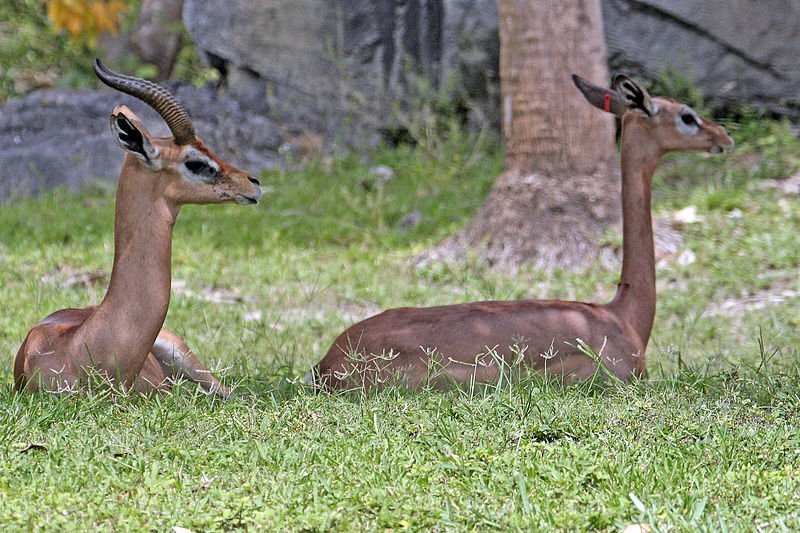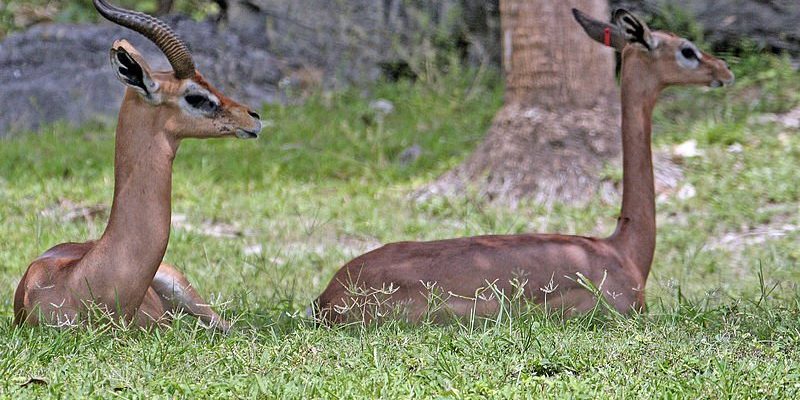
Gerenuks are native to East Africa, especially in arid places like Kenya and Tanzania. They’re known for their long necks and slender bodies, which make them look almost like a living piece of art. But it’s not just their looks that are impressive; it’s how they manage to find food and water in places where many other animals struggle. Let’s dive into the incredible ways these animals have adapted to survive in harsh climates.
Unique Physical Adaptations
One of the standout features of the gerenuk is its long neck. This isn’t just for show; it helps them reach leaves and shoots that are way above the ground, especially in thorny bushes where other herbivores can’t reach. Picture a tall shelf in your kitchen that only you can access; that’s basically how gerenuks snack on their favorite meals.
Gerenuks also have elongated legs, which not only help them reach high plants but also allow them to travel longer distances in search of food. With these adaptations, they can cover vast areas, looking for the tastiest leaves or the juiciest fruits, all while conserving energy. This is crucial when resources are scarce.
Another fascinating adaptation is their ability to stand on their hind legs. When they lift themselves up like this, they can access even higher foliage—talk about a buffet! It’s like discovering a secret menu when you thought you had seen all the options. This unique feeding behavior sets them apart from many other grazing animals.
Efficient Water Conservation
Now, let’s talk about water, which is often the most limiting resource in a dry environment. Gerenuks have evolved with *incredible kidneys* that allow them to conserve water exceptionally well. Here’s the thing: they can extract moisture from the leaves they eat, which means they don’t need to drink water as often as you might expect.
During the hottest months, when water sources are almost non-existent, the gerenuk’s body is a well-oiled machine for retaining hydration. They can even survive on the moisture found in the plants they consume. So, while you might need to gulp down water after a long hike, these gentle gazelles can go surprisingly long without it.
To top it off, gerenuks are primarily nocturnal. They feed during cooler hours—early mornings and late evenings—reducing their need for water and their exposure to the harsh sun. It’s a smart strategy, allowing them to avoid the hottest parts of the day when resources are slim.
Dietary Flexibility
Speaking of food, the gerenuk’s diet is quite varied, which is another key part of how they survive. They are browsers, meaning they prefer to eat leaves, fruits, and flowers instead of grass. This dietary strategy gives them access to a wider range of food sources, especially when competition is high.
Gerenuks will eat whatever is available, but they have favorites like acacia leaves and various shrubs found in their habitat. Their long necks let them reach the most desirable bits, while other animals might be stuck nibbling on the ground. This flexibility is crucial; when one plant is depleted, they can quickly switch to another.
Here’s a fun fact: even though gerenuks are picky eaters, they are also opportunistic. When the dry season makes their preferred food scarce, they’ll adapt their diet to include less-tasty but readily available options. Think of it like choosing a second-best restaurant when your favorite one is closed—better than going hungry!
Behavioral Adaptations
Behavior plays an essential role in how gerenuks adapt to their environments. They are extremely agile and can run swiftly when necessary, which is crucial for escaping predators. Imagine a game of tag in a wide-open field; being quick and nimble makes all the difference.
Another interesting behavioral adaptation is their herd dynamics. Gerenuks often gather in small groups or pairs, which helps them stay vigilant against threats. When you have friends around, it’s easier to notice when something’s amiss. Having a keen eye is vital in the wild, where danger can be lurking around any corner.
These animals also communicate using a variety of vocalizations and body language. When they detect a potential threat, they use different sounds to alert others in their group. This teamwork enhances their chances of survival, ensuring that everyone stays safe and informed.
Interdependence with the Ecosystem
The survival of gerenuks isn’t just about their individual traits; they also play a significant role in their ecosystem. By browsing on certain plants, they help shape the vegetation in their environment. If they munch on particular leaves, these plants may grow back stronger, which can benefit other species too.
Moreover, their feeding habits help disperse seeds. When they eat fruits and later excrete the seeds, they’re essentially planting new plants in different areas. This process is like planting a tree every time you enjoy a piece of fruit; it contributes to the growth of the environment around them.
The interdependence doesn’t stop there. Gerenuks also serve as prey for larger predators, which means they help maintain the balance of nature. Without their presence, the food chain would be disrupted, leading to potential overpopulation of their plant sources and affecting the entire habitat.
Challenges and Conservation Efforts
Despite their incredible adaptations, gerenuks face significant challenges today. Habitat loss due to agriculture and urban development is a primary concern. As humans expand into their territory, these beautiful animals find fewer resources available to them. It’s like trying to enjoy a picnic in a busy parking lot—not ideal!
Additionally, poaching and hunting have historically reduced their populations. Conservation efforts are in progress to protect these animals and their habitats. Initiatives like wildlife reserves and community awareness programs are essential for maintaining their numbers.
You might be wondering, what can we do to help? Supporting wildlife conservation organizations, spreading awareness about the importance of ecosystems, and advocating for sustainable practices can make a big difference. Every little bit helps in ensuring that the gerenuk and its habitat can thrive long into the future.
Gerenuks are remarkable creatures that showcase the resilience of wildlife in harsh environments. With their unique adaptations, impressive survival strategies, and vital role in their ecosystems, they remind us of the beauty and complexity of nature. Just like a talented athlete, they have honed their skills to thrive against the odds.
By understanding how gerenuks survive, we can appreciate the delicate balance of their habitats and the importance of conservation efforts. Whether you’re a nature enthusiast or just curious about the world around you, learning about these fascinating gazelles opens up a window into the wonders of life in tough climates. Let’s work together to protect these incredible animals and their homes for future generations to enjoy.

